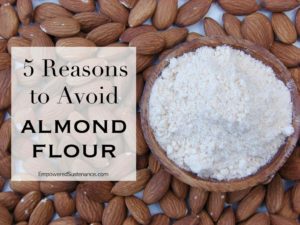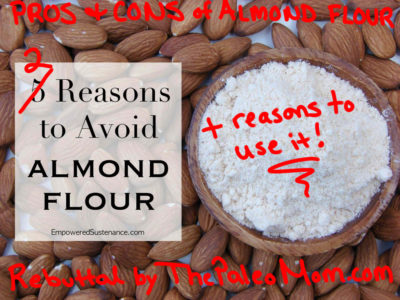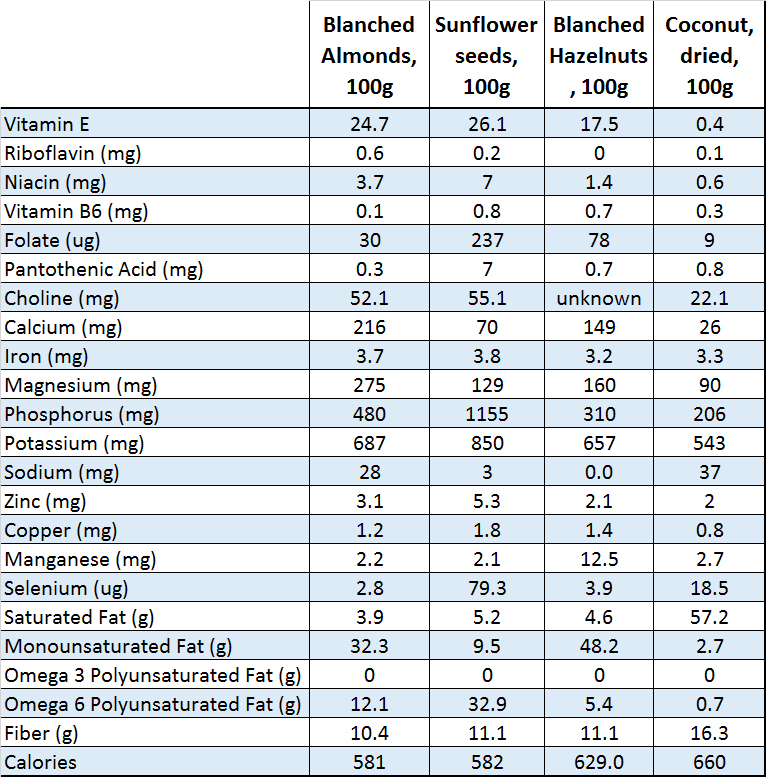I get asked surprisingly often to rebut or respond to posts or articles that criticize or question either some aspect of the Paleo diet or some frequently used ingredient. I have to be honest: I don’t like writing rebuttals. In part, because I don’t enjoy engaging in discussions with people whose minds are already made up. In part, because too often what aspect of the Paleo diet that is being criticized isn’t even representative of mainstream Paleo (which I consider myself to be part of). When this is the case, my rebuttal usually goes something like “I agree completely with those points, but that’s not a Paleo diet” (a good example is my rebuttal to the Weston A Price Foundation Summer 2013 Newsletter which you can read here). In part, I dislike writing rebuttals because I always like to go to the science and sometimes the science doesn’t actually give us the answer (although I love talking about papers, study design, conflicting results, and implications for human health, as long as we can agree to continue to reevaluate our positions as new science is performed). In part, because I’m just not a confrontational type person and I believe that everyone is entitled to their opinion and entitled to share their opinion (even if the way they share it is offensive and personally insults me), and I’m a strong believer in self-experimentation: if you find something that works for you, awesome. But I digress…
This rebuttal isn’t about an attack on the Paleo diet (or whether being leaner and fitter would give me more credibility… oh, sorry, there’s that tangent again…). It’s quite simply a response to a question that I get asked several times per week: is almond flour a good choice?
 Lauren from Empowered Sustenance, who I deeply respect, published a compelling article titled “5 Reasons to Avoid Almond Flour” in April of this year. The overarching message of this post is that coconut flour is a better choice than almond flour for Paleo baking. I have been asked so many times what my thoughts are on this article that I decided it was time to actually publish an official response. I’m going to address the 5 reasons provided in the article, point by point.
Lauren from Empowered Sustenance, who I deeply respect, published a compelling article titled “5 Reasons to Avoid Almond Flour” in April of this year. The overarching message of this post is that coconut flour is a better choice than almond flour for Paleo baking. I have been asked so many times what my thoughts are on this article that I decided it was time to actually publish an official response. I’m going to address the 5 reasons provided in the article, point by point.
Reason 1. Almond flour skews perception about quantity
I agree, but I think this applies to all flours. Pre-chewed food (which is what ground almonds are) definitely skews your ability to perceive how many calories you are consuming. However, this applies to any flour. Almost anything you make with any flour or flour substitute is going to be physically easier to chew and swallow than if you were eating the whole food source of that flour.
Another related issue that the article doesn’t get into is food reward. Almost anything you bake with any flour, almond or otherwise, is going to be highly palatable (meaning that you will choose it over other, whole foods), typically relatively high carbohydrate too. This stimulates dopamine release, which actually affects your hunger hormone signals and leads to you wanting to eat more (or, at least it does in some people). In fact, research shows that one of the most effective strategies to lose weight is to make food bland and unpalatable.
Overconsumption is a problem with any treat, Paleo or not. And, it’s the reason why we always recommend that Paleo baked goods be consumed in moderation and only occasionally. I don’t think this is a compelling argument against almond flour so much as an argument to make treats a treat.
Reason 2. Almond flour is very high in inflammatory PUFAS
I agree 100%. My extensive research into the roles of long-chain omega-3 fatty acids (DHA and EPA) versus omega-6 fatty acids (AA) tells me that addressing gross imbalances in intake of these polyunsaturated fatty acids is one of the most critical things you can do to improve your health. And the fact is that almost all nuts and seeds are very high in omega-6 fatty acids (the exceptions are coconut, macadamia nut, and walnut).
If you choose to consume any nuts or seeds (whether a flour or whole), or poultry for that matter, it’s important to balance that omega-6 intake with plenty of seafood.
Reason 3. The fats in almond flour aren’t heat stable
I disagree. If you were cooking with almond oil, this would be true. But, research shows that polyunsaturated fats are much more heat stable when part of the whole foods (including the unadulterated seed, but also ground into meals and flours). The best research into the heat stability of polyunsaturated fats in baked goods comes from the study of flaxseed meal and research shows that only an extremely small percentage of the fats are oxidized during cooking. Researchers speculate that the reason the polyunsaturated fats in flaxseed meal are resistant to heat is because they are not isolated but rather are present in a matrix of other compounds that the flaxseeds contain (i.e., when they are bound to proteins, carbohydrates, other fats, fiber etc. that are part of the ground up seed). In addition, the presence of antioxidants in the whole ground seed reduces fat oxidation. These natural antioxidants include lignin fiber (rich in phenols, see this post) and vitamin E which nuts and seeds are particularly rich in.
Furthermore, the internal temperature of baked goods rarely exceeds 160F, which is well below the smoking point of even the most easily oxidized and unstable fats.
Reason 4. Almond flour is high in oxalates
I disagree, not that almonds are high in oxalates but that this might make them a bad choice. Oxalates are an anti-nutrient found in nuts, seeds, many vegetables (like spinach and rhubarb), and grains. Oxalic acid binds to minerals (forming oxalates, or oxalic acid salts), most notably calcium (forming calcium oxalate), and thus prevents the mineral’s absorption in the body. The concern with high intake of oxalate-rich foods is that this might contribute to calcium oxalate crystal formation, which is: a major component of the most common type of kidney stone; implicated in gout; and the problematic crystal deposited in joints in microcrystalline-associated arthritis.
Traditionally, a diagnosis of kidney stones comes with the recommendation to follow a low-oxalate, low protein diet. However, the scientific research doesn’t support this and recommendations are starting to change to reflect new understandings of the key players in kidney diseases: low dietary calcium, high fructose intake, gut dysbiosis, and chronic stress. Actually, research shows that higher oxalate diets reduce your chances of developing kidney stones. Even once you have developed kidney stones, low oxalate diets don’t appear to help (and as an aside, urine oxalate content which has long been used to assess kidney stone risk doesn’t actually appear to correlate at all!). What does seem to help? Increasing calcium ad eating more fruits and vegetables.
Nutrivore Weekly Serving Matrix
An easy-to-use and flexible weekly checklist
to help you maximize nutrient-density.
The Weekly Serving Matrix is very helpful! I’ve been eating along these lines but this really helps me know where to focus vs. which foods serve a more secondary role. It’s super helpful and has taken a lot of worry out of my meal planning. Thanks!
Jan
Reason 5. Coconut flour is healthier than almond flour
I mumble mumble. Eh. I don’t agree but I don’t strongly disagree either. Not that I think almond flour is some magical source of nutrition, but I don’t see coconut flour as a clearly better substitute. The article’s arguments about the fats being more heat stable is moot after you read my response to reason #3. It is true that a little goes a long way and this is owing to the fairly remarkable ability of coconut flour to absorb liquid. The reason why coconut flour is so good at absorbing liquid is that it is extremely high in inulin fiber, a highly soluble and viscous and highly fermentable fiber. Inulin is a FODMAP and may be a problem for people dealing with SIBO, leaky gut, FODMAP-intolerance, and IBS. (you might want to read this post and this post from my Fiber Manifesto about the differential effects of insoluble and soluble fiber, which also warns against diets overly high in soluble fiber).
Reason 6. Yes, I’m adding one.
(although this is really only the second strike against almond flour) Actually, there’s a very compelling reason to limit consumption of almond products (including whole almonds, almond butter, and almond flour) that is not discussed in this article: the cyanogenic glycosides content. Hydrogen cyanide, which is highly toxic, is released from cyanogenic glycosides when plants that contain them are chewed and digested (through an enzyme that is also present in the plant). Almonds have a particularly large amount of cyanogenic glycosides.
One Big Pro: Nutrient Density
This isn’t an argument for or against almond flour, but rather a comparison between four commonly used Paleo flour substitutes. You already know that I’m a big fan of nutrient density. I dislike the whole “almond flour is high in protein” argument because plant proteins are nowhere near as easy to digest as animal proteins. But almond flour and other nut and seed flours definitely have compelling amounts of vitamins, minerals and other phytonutrients, and while not all of these are particularly bioavailable (nuts and seeds also have phytates, which bind minerals, although as the article points out, these are concentrated in the skins which are typically removed before nuts and seeds around ground into flours), I think this is probably the best argument for or against a particular flour (or food in general!) that you can make. (By the way, the probiotic bacteria in your guts liberate many of the minerals from phytates and oxalates and other anti-nutrients present in your foods, so having good digestion in combination with a healthy diversity gut bacteria is one of the best things you can do to optimize the nutrient absorption from your food.)
This table compares the vitamins and minerals that nuts and seeds have a significant amount of. I also included a breakdown of the types of fats, fiber and calories per 100g. Because flours made from these are not in the USDA database, I used the whole (blanched when available) nut and compared against dried coconut (basically, the thing that is ground up to make flour). Keep in mind that you typically use less coconut flour (between one quarter and one half, depending on how finely ground it is and the exact recipe it’s being used it) than other nut or seed flours.
From a nutrient-density perspective, I think coconut is actually the clear loser (although, it’s true that those medium chain triglycerides are very healthy). And, I guess if your evaluation of the health of a treat was based purely on calories, coconut would win based on the fact that you can get away with using a fair bit less.
Final Thoughts…
I don’t think almond flour is a terrible flour. And I don’t think coconut is a better choice (not that I think you should avoid coconut flour either). But, just like everything in our diets, I think variety is important. You get different nutrients in different quantities from different foods. And the best thing you can do to protect yourself from nutrient excesses or deficiencies is to eat variety. So, mix it up. Almond flour, sunflower seed flour, and hazelnut flour can be used interchangeably. Other great options are chestnut flour, pumpkin seed flour, ground walnuts, and there are some great non-nut options too, like pumpkin powder, plantain flour, and various starches (arrowroot, tapioca, sweet potato, kuzu, water chestnut).
And remember that this whole discussion is about optimizing nutrition for a treat. If a treat really is just a treat, meaning you eat them occasionally and in moderation, the overall impact of suboptimal ingredients (providing you aren’t eating something that will actually hurt you, say by increasing intestinal permeability or stimulating the immune system) is pretty minimal.
Arzoz-Fabregas M, et al, Chronic stress and calcium oxalate stone disease: is it a potential recurrence risk factor? Urolithiasis. 2013 Apr;41(2):119-27.
Arzoz-Fàbregas M, et al. Chronic Stress and Calcium Oxalate Stone Disease: Influence on Blood Cortisol and Urine Composition. Urology. 2013 Oct 12. pii: S0090-4295(13)01067-4.
Fink HA, et al Recurrent Nephrolithiasis in Adults: Comparative Effectiveness of Preventive Medical Strategies [Internet].
Guseva DA, et al. [Antioxidant activity of vegetable oils with various omega-6/omega-3 fatty acids ratio]. Biomed Khim. 2010 May-Jun;56(3):342-50.
Hardman CA, et al. Dopamine and food reward: effects of acute tyrosine/phenylalanine depletion on appetite. Physiol Behav. 2012 Mar 20;105(5):1202-7.
Hyvarinen HK, Pihlava JM, et al. Effect of processing and storage on the stability of flaxseed lignan added to bakery products. J Agric Food Chem. 2006 Jan 11;54(1):48-53.
Knight J, et al, Metabolism of fructose to oxalate and glycolate. Horm Metab Res. 2010 Nov;42(12):868-73.
Manthey FA, et al. Processing and cooking effects on lipid content and stability of alpha-linolenic acid in spaghetti containing ground flaxseed. J Agric Food Chem. 2002 Mar 13;50(6):1668-71.
Marickar YM. Calcium oxalate stone and gout. Urol Res. 2009 Dec;37(6):345-7.
Okombo J, Liebman M. Probiotic-induced reduction of gastrointestinal oxalate absorption in healthy subjects. Urol Res. 2010 Jun;38(3):169-78.
Taylor EN, Curhan GC. Oxalate intake and the risk for nephrolithiasis. J Am Soc Nephrol. 2007 Jul;18(7):2198-204.
Taylor EN, Curhan GC. Fructose consumption and the risk of kidney stones. Kidney Int. 2008 Jan;73(2):207-12.
Volkow ND, et al. Reward, dopamine and the control of food intake: implications for obesity. Trends Cogn Sci. 2011 Jan;15(1):37-46.
Wanasundara PK and Shahidi F. Process-induced compositional changes of flaxseed. Adv Exp Med Biol. 1998;434:307-25.
Xu H, et al. Kidney stones: an update on current pharmacological management and future directions. Expert Opin Pharmacother. 2013 Mar;14(4):435-47.
Zheng H, Appetite control and energy balance regulation in the modern world: reward-driven brain overrides repletion signals. Int J Obes (Lond). 2009 Jun;33 Suppl 2:S8-13.












